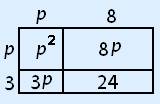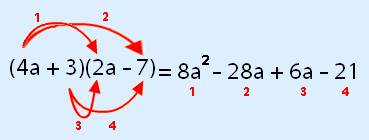Simplifying formulas » Removing brackets
In a formula you can sometimes find brackets. You can remove these brackets. If you have to shorten a formula, you always have to remove the brackets, if there are any.
Removing brackets can be done in three ways:
1. Rectangle method
2. Parrot's beak method
3. Multiplication table
Method 1 is also proof that both formulas will be equal.
Remember that a multiplication sign does not have to be written down next to a letter? So 5a means 5 × a and 4(3 + a) means 4 × (3 + a)
Contents
Single brackets1. Rectangle method
2. Parrot's beak method
3. Multiplication table
4. Examples single brackets
Double brackets
1. Rectangle method
2. Parrot's beak method
3. Multiplication table
4. Example double brackets
Single brackets
Method 1: Rectangle method
Let's write q = 2(p + 8) without brackets.
You can do this by imagining a rectangle with a height of 2 and a width of p + 8.

The area of this rectangle is 2 × p + 2 × 8 = 2p + 16. Therefore:
q = 2(p + 8) = 2p + 16.
You can see in the rectangle that the are of the left-hand part is 2p and the right-hand part is 2 × 8 = 16. Together q = 2p+ 16.
Method 2: Parrot's beak method
The Parrot's beak method is the fastest of the three. You know that you have to multiply the factor in front (or behind) the brackets with the terms between the brackets. As help, you can draw arrows (or lines) from the factor to the terms. Along these arrows you start multiplying.

Arrow 1 gives 3 × 2a = 6a
Arrow 2 gives 3 × 4 = 12
Method 3: Multiplication table
The exercise is put in a multiplication table with this method.
The factor is put in the first column and the terms are put in the top row.
After that, you start multiplying the factor with the terms.
Example
Shorten b = 5a(2a + 4).
| × | 2a | 4 |
| 5a | 10a2 | 20a |
The green text is filled in, according to the given formula. The red text is what you calculate yourself. The answer will be the red text added.
In this case, that will be b = 10a2 + 20a
Examples single brackets
b = 3a(5a + 3) = 15a2 + 9a
b = 3a(5a – 3) = 15a2 – 9a
b = 3a(–5a + 3) = –15a2 + 9a
b = 3a(–5a – 3) = –15a2 – 9a
b = –3a(5a + 3) = –15a2 – 9a
b = –3a(5a – 3) = –15a2 + 9a
b = –3a(–5a + 3) = 15a2 – 9a
b = –3a(–5a – 3) = 15a2 + 9a
Important:
b = –(5a – 3) = –5a + 3
b = (4a – 7)3 = 12a – 21
b = (4a – 7) + 3 = 4a – 7 + 3 = 4a – 4
Example for the advanced (steps are written underneath each other):
–2a(b – 3c) – 5c(a + 2b) =
–2ab + 6ac – (5ac + 10bc) =
–2ab + 6ac – 5ac – 10bc =
–2ab + ac – 10bc
Double brackets
Method 1: Rectangle method
Let's write q = (p + 3)(p + 8) without brackets.
You can imagine a rectangle with a height of p + 3 and a width of p + 8.

For every box/square you can find the area.
The area of the whole rectangle will then be:
q = p2 + 8p + 3p + 24 = p2 + 11p + 24.
Method 2: Parrot's beak method
The Parrot's beak method is the fastest of the three. Make sure you multiply every term between the first set of brackets with the every term between the second set of brackets.
As a help, you can draw the arrows (or lines) again. Along these arrows you start multiplying.

Arrow 1 gives 4a × 2a = 8a2
Arrow 2 gives 4a × –7 = –28a
Arrow 3 gives 3 × 2a = 6a
Arrow 4 gives 3 × –7 = –21
These for answers are added:
8a2 – 28a + 6a – 21 = 8a2 – 22a – 21
Method 3: Multiplication table
The exercise is put in a multiplication table with this method.
The terms of the first factor are put underneath each other in the first column and the terms of the second factor are put next to each other in the top row.
Example
Shorten b = (3 + 5a)(2a – 4).
| × | 2a | –4 |
| 3 | 6a | –12 |
| 5a | 10a2 | –20a |
The green text is filled in, according to the given formula. The red text is what you calculate yourself. The answer will be the red text added.
In this case, that will be b = 6a + –12 + 10a2 + –20a = 10a2 – 14a – 12.
Examples double brackets
|
(2a + 3)(4a + 3) = 8a2 + 6a + 12a + 9 = 8a2 + 18a + 9 |
(3a + 2)(5a – 3) = 15a2 – 9a + 10a – 6 15a2 + a – 6 |
|
(5a – 7)(4a – 6) = 20a2 – 30a – 28a + 42 = 20a2 – 58a + 42 |
(5a + 3b)(2a – 7b) = 10a2 – 35ab + 6ab – 21b2 = 10a2 – 29ab – 21b2 |
|
–(2a + 4)(5a – 3) = –(10a2 – 6a + 20a – 12 = –(10a2 + 14a – 12) = –10a2 – 14a + 12 |
5(3a + 5)(2a + 3) = 5(6a2 + 9a + 10a + 15) = 5(6a2 + 19a + 15) = 30a2 + 95a + 75 |
|
(3a – 4a2)(5a – 3) = 15a2 – 9a – 20a3 + 12a2 = –20a3 + 27a2 – 9a |
(3a2b – b3)(2b2 – a) = 6a2b3 – 3a3b – 2b5 + ab3 |